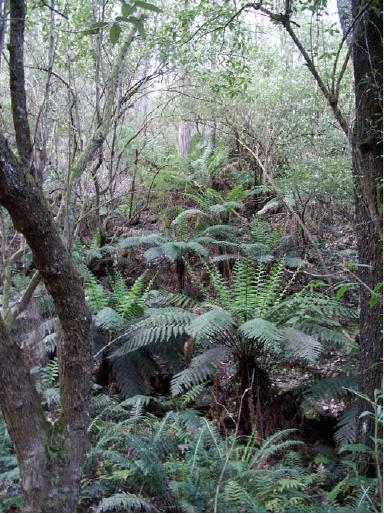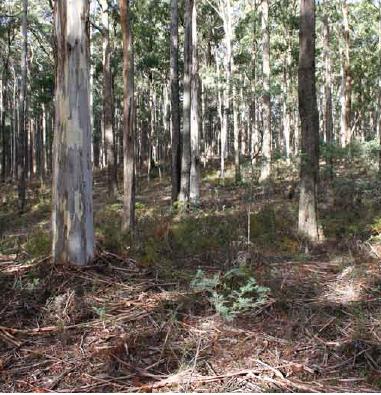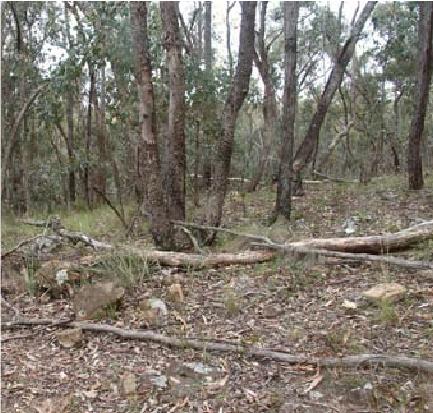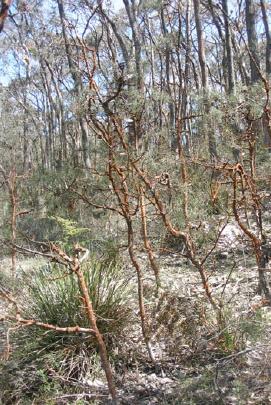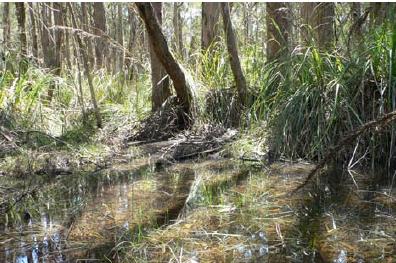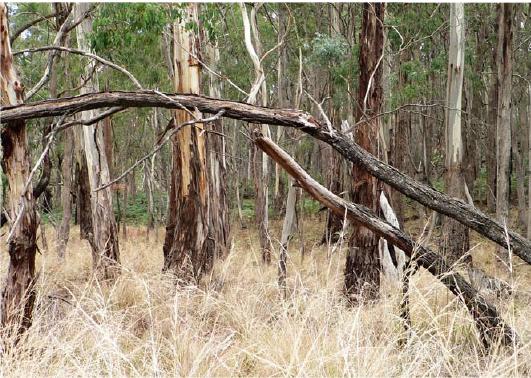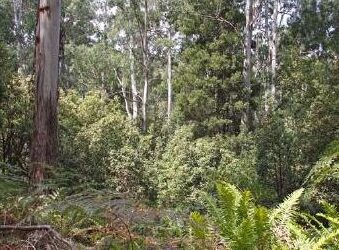In the Wombat State Forest, damp forest occurs in the higher rainfall areas where annual rainfall is between 950-1200mm per annum. It is usually restricted to sheltered gullies on alluvial soils, often in association with Shrubby Foothill Forest. The tall overstorey...
Ecological vegetation classes
- HOME
- |
- Environment + Biodiversity
- |
- Ecological vegetation classes
- HOME
- |
- Environment + Biodiversity
- |
- Ecological vegetation classes
The types of native vegetation that occur across Victoria vary significantly.
This variation reflects differences in geology, soil type, aspect, climate, altitude and position in the landscape. Depending on these environmental conditions, particular plant species and groups of plants will tend to grow together. The term used to describe these distinct native vegetation types or plant communities is Ecological Vegetation Class (EVC).
Within the Wombat Forest approximately 16 different EVC’s have been mapped (although more mapping is required). The most common EVC in the Wombat Forest is Shrubby Foothill Forest. It occurs on both sides of the Great Divide, but is particularly extensive on the southern side of the divide.
EVCs in the Wombat State Forest
| EVC | EVC number | Bioregional Conservation Status | % Wombat |
|---|---|---|---|
| Swampy Riparian Woodland | EVC 83 | Endangered | 0.17 |
| Streambank Shrubland | EVC 851 | Endangered | 0.00 |
| Riparian Forest | EVC 18 | Vulnerable | 0.92 |
| Valley Grassy Forest | EVC 47 | Vulnerable | 0.97 |
| Creekline Herb-rich Woodland | EVC 164 | Vulnerable | |
| Sedgy Riparian Woodland | EVC 198 | Depleted | 2.41 |
| Grassy Forest | EVC 128 | Depleted | 0.02 |
| Grassy Woodland | EVC 175 | Vulnerable | 0.01 |
| Grassy Dry Forest | EVC 22 | Depleted | 1.69 |
| Shrubby Dry Forest | EVC 21 | Least concern | 2.56 |
| Midlands Heathy Woodland | EVC 48-13 | Depleted | 0.40 |
| Heathy Dry Forest | EVC 20 | Least concern | 8.79 |
| Herb-rich Foothill Forest | EVC 23 | Depleted | 13.73 |
| Herb-rich Foothill Forest/ Shrubby Foothill Forest Complex | EVC 178 | Depleted | 6.84 |
| Shrubby Foothill Forest | EVC 45 | Least concern | 57.66 |
| Damp Forest | EVC 29 | Vulnerable | 1.47 |
EVC status and criteria
The status of an EVC is established by a number of criteria which include depletion (how much of the EVC remains since European settlement), degradation, current threats and rarity. The table below is a simplified version of this criteria.
| Status | Criteria |
|---|---|
| Endangered | Less than 10% pre-European extent remains. |
| Vulnerable | 10 to 30% pre-European extent remains. |
| Depleted | Greater than 30% and up to 50% pre-European extent remains. |
| Rare | Rare EVC (as defined by geographic occurrence) but neither depleted, degraded nor currently threatened to an extent that would qualify as Endangered, Vulnerable or Depleted. |
| Least Concern | Greater than 50% pre-European extent remains and subject to little to no degradation over a majority of this area. |
By Murray Ralph
Shrubby Foothill Forest (EVC 45)
Occurs on moderately fertile clay soils derived from shale and sandstone towards the top of the Great Dividing Range at higher elevations (500-900m above sea level) and rainfall zones (750-1200mm). In wetter areas it may occur on all slopes and aspects, but in drier...
Herb-Rich Foothill Forest (EVC 23)
This EVC occurs on both fertile soils derived from basalt and the less fertile soils derived from Ordovician shales and sandstones. Altitude is usually 600-900m above sea level and annual rainfall generally between 800-1000mm per annum. The overstorey is a medium to...
Heathy Dry Forest (EVC 20)
Heathy Dry Forest is found on gently undulating hills to steeper slopes and ridge tops with shallow, skeletal soils with low fertility and water-holding capacity. This EVC has a scattered occurrence to the north, north-west and north-east of Daylesford, including in...
Midlands Heathy Woodland (EVC 48-13)
In the Wombat Forest, Heathy Woodland occurs on the top of dry ridges in the higher rainfall areas (900-1100mm), at altitudes of 600-830m above sea level. Soils are very fine white clay that are nutrient poor. The overstorey is dominated by Broadleaf Peppermint...
Sedgy Riparian Woodland (EVC 198)
This vegetation community has a scattered distribution across the Wombat State Forest. It usually occurs in narrow bands along broad, flat drainage lines, which may be seasonally inundated. However, in some parts of the Wombat Forest, such as south of Trentham, it can...
Valley Grassy Forest (EVC 47)
Valley Grassy Forest has a scattered occurrence in drier sections of the Wombat State Forest where rainfall is below 800mm per annum. It usually occurs on valley floors on alluvial soils (soils that have been deposited in the valleys by erosion) and at altitudes less...
Riparian Forest (EVC 18)
Riparian forest is scattered throughout the forest as narrow strips along the banks and alluvial terraces of (usually) perennial rivers and streams. Soils are fertile, well-drained and a constant supply of moisture supports a tall, multi-layered, species rich forest....

